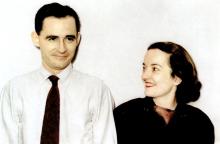Tribute to a Writer: Kathryn Swarthout (1919 - 2015)
When the ASU community talks about the Swarthout Awards—the generous creative writing prizes created by Glendon and Kathryn Swarthout in 1962—they often focus on the work of Glendon, a former ASU professor, novelist, and screenwriter. They talk about his book The Shootist getting made into John Wayne’s last movie and about his 1960s novel Where the Boys Aredefining for America the concept of spring break. They mention that Glendon taught for years at Michigan State University before he reached ASU, and that the film version of his recently reissued novel The Homesman made a splash at Cannes last year, with Tommy Lee Jones as both star and director.
But sometimes they overlook the fact that Kathryn Swarthout, who passed away in April 2015, was a formidable literary presence and educator herself.
It’s true that the Swarthouts traveled widely together, and she was a great supporter of his work. They had a son, Miles, who has carried on his family’s legacy with his novel The Last Shootist and other projects. It’s also true that Kathryn and Glendon created the Swarthout Awards in Writing, which for more than 50 years have provided emerging ASU writers with financial and creative support.
But many don’t know that Kathryn wrote a free-form poetry column,Lifesavors, which ran in Woman's Day Magazine for more than twenty years. Or that a compilation of the pieces in her book of the same name, Lifesavors, was published by Doubleday in 1982.
Kathryn’s column, in fact, earned quite a following. Just check out her Amazon reviews for Lifesavors. One reviewer wrote: “I followed Kate Swarthout’s column in Woman’s Day for years for the small Lifesavors list each month. These make lovely hostess gifts or friendship gifts and they are a joy.” Another said: “I used to read these every issue of Woman’s Day-even clipped and saved some! NOW I've got the book-yea!”
People may not realize that Kathryn received a Certificate of Merit in Literature from the National Society of Arts and Letters for her writing, or that she earned a Master’s in Education and taught elementary school for years.
Many also don’t realize that Kathryn co-authored with her husband six novels for young readers. These six books show a range in subject matter and often an extraordinary amount of compassion for the characters. Their novel Whales to See The, for example, focuses on a group of children with learning disabilities. Whichaway depicts a lonesome yet resilient boy struggling on an Arizona ranch in the 1920s. The boy survives several days and nights stranded at the top of a windmill.
The third novel Kathryn and Glendon co-authored, The Button Boat, was named an Outstanding Childrens’ Book of 1969. Book World wrote: “Two beaten-down children of the Depression triumph over a wicked stepfather in a story that is melodramatic, suspenseful and funny.”
In their novel TV Thompson, the title character journeys into the nightmarish landscape of Televisionland, where he confronts his own habits of consumption. The Ghost and the Magic Saber details a boy’s summer adventures on a farm. And their book Cadbury’s Coffin is described as “a grand entertainment in the Victorian manner, acted out by characters both valiant and villainous, and stuffed to the margins with shivers and mystery.” In these works, both Kathryn and her husband showed a breadth of imagination.
Kathryn’s compassion, evident in her writing, also carried into her community work. She belonged to a Paradise Valley book club and volunteered as a reading and writing tutor for slow-learning elementary students. In 2010, the Western Writers of America honored her with their Branding Iron Award for 35 years of service.
While it is true that Glendon Swarthout’s name maybe more immediately recognized, the writer Kathryn Swarthout should also be remembered for her many achievements, both literary and within the wider community.
—Corey Campbell
Photo of Kathryn Swarthout courtesy Miles Swarthout.
Photo of Glendon and Kathryn Swarthout courtesy Miles Swarthout.
Header background image from 1968 or 1969: a demonstration at the ASU Administration office. UP UPC ASUG S886 1960s #1


